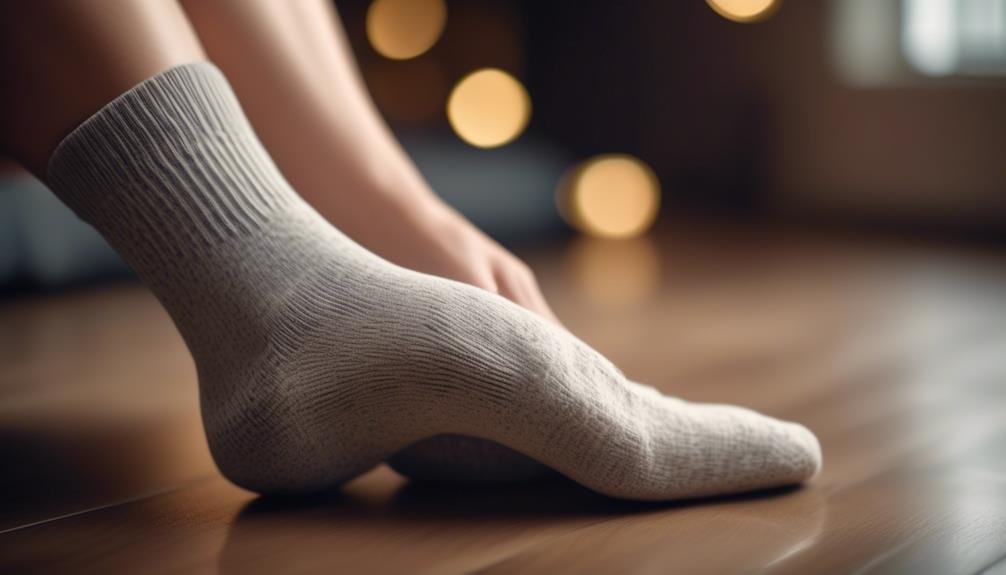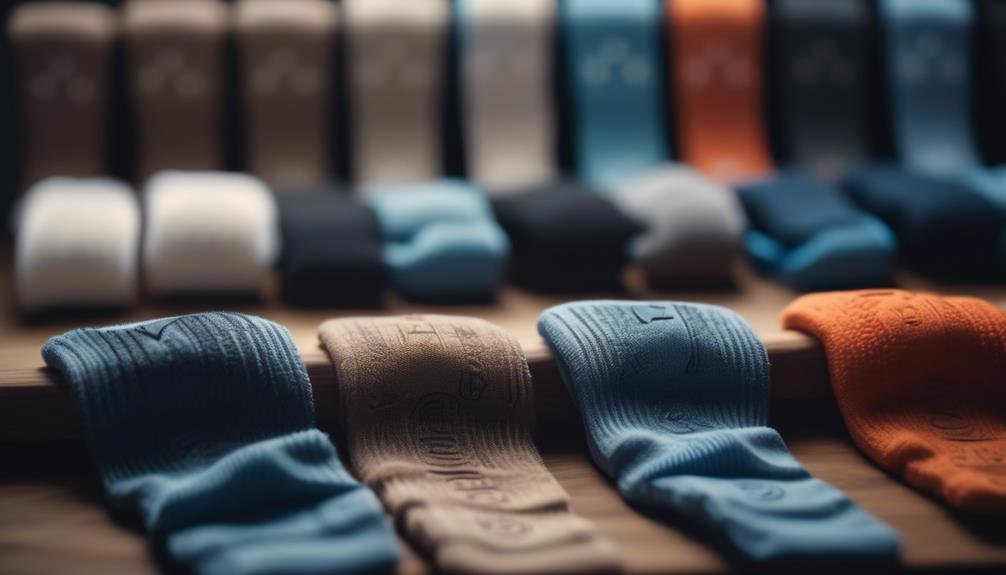Diabetic Podiatry Essentials
Discover the Secret to Healthier Feet: The Surprising Benefits of Diabetic-Friendly Socks

Foot health is a crucial aspect of overall well-being, particularly for individuals managing diabetes, where the risk of foot complications is significantly heightened. Diabetic-friendly socks are engineered to offer a unique combination of protection, comfort, and support, addressing the specific needs of those with diabetes.
These specialized socks are designed to minimize the risk of irritation, enhance blood circulation, and provide moisture control, thus potentially reducing the likelihood of infections and other foot-related ailments. Their role in preventative foot care is often understated, yet understanding the subtle nuances of how they can contribute to healthier feet can be a game-changer for many.
As we explore the intricacies of these seemingly simple garments, one might uncover how the right choice in socks could lead to a marked improvement in foot health and, consequently, a better quality of life.
Key Takeaways
- Diabetic-friendly socks address the specific needs of individuals managing diabetes, minimizing the risk of foot complications, irritation, and infections.
- Regular foot inspections, both self-examinations and professional check-ups, are essential for early detection and prevention of issues related to diabetic foot care.
- Selecting the right footwear, such as diabetic shoes with arch support, a wider toe box, and cushioning, is crucial for minimizing pressure points and preventing sores and blisters.
- Choosing appropriate fabrics for diabetic socks, such as moisture-wicking and antimicrobial materials, helps keep feet dry, reduce the risk of infections, and provide comfort-enhancing properties.
Understanding Diabetic Foot Care
Effective diabetic foot care is crucial for preventing complications that can arise from the condition's impact on circulation and nerve health in the lower extremities. People living with diabetes are at an elevated risk for foot ulcers, infections, and in severe cases, amputation. Therefore, a comprehensive foot care routine is essential for maintaining foot health and avoiding these serious outcomes.
Regular foot inspections play a pivotal role in diabetic foot care. Individuals with diabetes should examine their feet daily for any signs of cuts, blisters, redness, or swelling. Early detection of these issues allows for prompt treatment, reducing the risk of infection and further complications. It's also advisable to have feet professionally examined by a healthcare provider on a regular basis to identify any potential concerns that may not be easily noticeable to the patient.
Infection prevention is another key aspect of diabetic foot care. Maintaining good foot hygiene, keeping feet dry and clean, and wearing appropriate footwear all contribute to reducing the likelihood of infections. Diabetic-friendly socks, which are designed to minimize pressure points, manage moisture, and reduce the risk of blistering, can be particularly beneficial in safeguarding against infections by providing a protective barrier between the foot and potential irritants.
Footwear Essentials for Diabetics
Selecting the right footwear is a cornerstone of diabetic foot care, as it not only provides comfort but also plays a critical role in preventing injury and complications. For individuals with diabetes, shoes must offer more than a snug fit; they must ensure shoe compatibility with the specific needs of their feet. Properly fitting diabetic shoes are designed to minimize pressure points that can lead to sores and blisters, common issues that can escalate into severe problems due to diabetic neuropathy.
Arch support is another crucial feature in diabetic footwear. It helps distribute weight evenly, reducing strain on the foot's structure and lowering the risk of foot deformities, which can be exacerbated by diabetes. Diabetic shoes typically come with a wider toe box to accommodate changes in foot shape and to prevent rubbing against the toes. The shoes should also provide cushioning to absorb impact and reduce stress on the bottom of the feet.
Fabrics That Favor Diabetic Feet

Selecting the appropriate fabric for diabetic socks is crucial in promoting foot health and comfort. Moisture-wicking materials are essential to keep feet dry, thereby reducing the risk of fungal infections.
Additionally, incorporating antimicrobial features and comfort-enhancing fibers can significantly improve the daily well-being of individuals with diabetes.
Moisture-Wicking Material Benefits
Moisture-wicking materials are instrumental in managing perspiration, a critical factor in maintaining foot health for individuals with diabetes. By effectively drawing moisture away from the skin, these fabrics help to prevent the damp environment that can lead to infections and skin complications. Here are the benefits such materials offer:
- Enhanced Skin Health: They reduce the risk of fungal infections and skin breakdown, thus promoting overall skin health.
- Reduced Friction: Dryer skin minimizes friction within the shoe, lowering the chance of blisters.
- Temperature Regulation: By keeping the feet dry, these materials help in maintaining a stable foot temperature, which is beneficial for athletic performance and daily comfort.
- Odor Control: Less moisture means reduced bacterial growth, resulting in fewer unpleasant odors.
Essential Antimicrobial Fabric Features
Antimicrobial fabrics are a cornerstone in diabetic foot care, offering protection against bacteria and fungi that can cause serious infections in individuals with compromised immunity. These specialized fabrics are embedded with agents that inhibit microbial growth, ensuring antimicrobial effectiveness throughout the life of the sock. A key attribute of these fabrics is their breathability, which plays a crucial role in maintaining a dry environment that is less conducive to the proliferation of pathogens.
The integration of these features into diabetic-friendly socks creates a healthier microclimate for feet, reducing the risk of infections that can lead to severe complications. For diabetic patients, this protection is not just a matter of comfort but a vital aspect of their overall foot health management strategy.
Comfort-Enhancing Fiber Technologies
While antimicrobial properties are essential for preventing infections, comfort-enhancing fiber technologies further support diabetic foot health by providing softness, stretchability, and pressure relief. These specialized fibers are meticulously engineered to cater to the unique needs of diabetic feet.
Here are key features:
- Fiber resilience: Materials that maintain shape and provide consistent cushioning, reducing impact and the risk of pressure points.
- Moisture-wicking capabilities: To keep feet dry and minimize the potential for fungal growth.
- Thermal regulation: Fabrics that respond to temperature changes, keeping feet warm in cold conditions and cool in the heat.
- Seamless construction: To minimize friction and the chance of blisters, enhancing overall comfort for sensitive diabetic feet.
These technologies come together to create a sock that not only protects but also maximizes comfort for the wearer.
Sock Designs for Better Circulation

When considering the health of individuals with diabetes, proper circulation is paramount. Sock design plays a crucial role in supporting circulatory wellness. Features such as gradient pressure, which gently compresses the leg in a graduated manner, can enhance blood flow and reduce swelling.
Additionally, non-binding top bands are instrumental in preventing constriction. This promotes better circulation without compromising comfort.
Enhancing Circulatory Health
Designed to promote blood flow, diabetic-friendly socks often feature non-binding tops and a gradient compression that can significantly enhance circulatory health in individuals with diabetes. These specialized socks are engineered for blood flow optimization and improved vascular health, two critical aspects for those managing diabetes. Here are key features that contribute to their effectiveness:
- Non-Binding Tops: Reduce constriction and allow for unimpeded circulation.
- Mild Compression: Supports veins and promotes upward blood flow.
- Seamless Design: Minimizes friction and the risk of blisters, which can affect circulation.
- Moisture-Wicking Fabric: Keeps feet dry, reducing the risk of infection that could compromise vascular health.
Gradient Pressure Features
Understanding the gradient pressure features in diabetic-friendly socks is pivotal for appreciating their role in promoting better circulation for individuals with diabetes. These socks use varying compression levels to provide vascular support where it's most needed, encouraging blood flow from the lower extremities back towards the heart.
The strategic design involves tighter compression at the ankle, which gradually lessens towards the knee. This helps to combat the effects of gravity, reduces swelling, and aids in the prevention of blood clots. It's not just about comfort—effective gradient pressure can significantly improve foot health for diabetics.
Here's a glance at how gradient pressure works:
| Compression Zone | Effect on Circulation | Emotional Benefit |
|---|---|---|
| Ankle | Maximum compression | Security |
| Calf | Moderate compression | Relief |
| Knee | Light compression | Freedom |
| Overall | Improved circulation | Peace of Mind |
Non-Binding Top Bands
Building on the importance of gradient pressure, non-binding top bands in diabetic-friendly socks complement this feature by ensuring that the upper edge does not restrict blood flow or cause discomfort. These top bands are specifically designed to offer:
- Optimal Fit: They adapt to the shape of the leg without exerting excessive pressure.
- Enhanced Comfort: Band comfort is prioritized to reduce the risk of skin irritation and marks.
- Improved Circulation: By avoiding constriction, they promote better blood flow, essential for diabetic patients.
- Durable Elasticity: Sock elasticity is balanced to maintain shape while preventing tightness.
Such attributes are crucial in diabetic sock designs to provide support and protection while enhancing overall foot health. Non-binding top bands play a pivotal role in achieving this balance.
Importance of Moisture Control

Effective moisture control in diabetic-friendly socks is crucial as it helps to prevent the growth of bacteria and fungi, reducing the risk of foot infections commonly faced by individuals with diabetes. Maintaining good skin health is of paramount importance for those with diabetes because their immune systems are often compromised, making it harder to fight off infections. Excess moisture can create an environment conducive to the development of fungal infections such as athlete's foot, which not only are uncomfortable but can also lead to more serious complications if left untreated.
Diabetic-friendly socks are designed with materials that wick moisture away from the skin, keeping the feet dry and less susceptible to infection. The ability to control moisture also reduces the likelihood of blisters and sores, which can be particularly problematic for diabetics, as these can take longer to heal and may lead to more severe issues.
Padding: A Cushion for Comfort
While moisture control is essential for preventing infections, the addition of adequate padding in diabetic-friendly socks offers an extra layer of comfort and protection for sensitive feet. The strategic placement of padding is crucial in these specialized socks, as it serves multiple purposes:
- Pressure Redistribution: By evenly distributing pressure across the foot, padding helps prevent the formation of pressure points, which can lead to ulcers and sores, particularly in individuals with diabetes who may have reduced sensation in their feet.
- Blister Prevention: The padding in diabetic-friendly socks minimizes friction and rubbing, which are common causes of blisters. This is particularly important as even minor blisters can become serious concerns for those with diabetes.
- Shock Absorption: Extra cushioning reduces the impact on the feet during walking or running, providing a safeguard against the jarring forces that can cause discomfort or injury.
- Insulation and Warmth: Padding also adds a layer of warmth, which is beneficial for those with diabetes who may have poor circulation and are prone to cold feet.
Incorporating these features, diabetic-friendly socks with adequate padding support a healthier foot environment, contributing to overall foot health and comfort.
Guide to Choosing Diabetic Socks

Selecting the right diabetic socks involves considering several critical features to ensure maximum comfort and protection for sensitive feet. Sock elasticity is a paramount consideration; diabetic socks should have a non-binding top to improve circulation, yet they must stay up without slipping down. Look for socks with minimal or no elastic at the edge to reduce constriction.
When assessing diabetic socks, examine the materials used. Fabrics should be moisture-wicking to keep feet dry, reducing the risk of infection. Additionally, a seamless design is crucial to decrease friction and prevent blisters or ulcers. Padding in the sole can offer extra cushioning and distribute pressure more evenly.
Another aspect to consider is the color variety available. While not directly related to health, light-colored socks can alert wearers to draining wounds or other foot issues that may otherwise go unnoticed with darker fabrics.
Frequently Asked Questions
Can Diabetic-Friendly Socks Help With Foot Odor Issues Common in Diabetic Individuals?
Diabetic-friendly socks, utilizing advanced material technology, enhance foot hygiene and may reduce odor by controlling moisture, a common issue for diabetic individuals seeking to maintain healthy feet.
Are There Any Risks Associated With Wearing Diabetic-Friendly Socks for Non-Diabetics?
Non-diabetics wearing diabetic-friendly socks generally face minimal risks. However, individuals with sock allergies should verify material breathability and composition to prevent adverse reactions. Overall, these socks are designed for safety and comfort.
How Do Diabetic-Friendly Socks Interact With Different Types of Skin Conditions, Such as Eczema or Psoriasis?
Diabetic-friendly socks offer enhanced skin compatibility and moisture management, which can be beneficial for individuals with eczema or psoriasis by reducing irritation and maintaining a dry environment to prevent exacerbation of symptoms.
Is There Any Evidence to Suggest That Diabetic-Friendly Socks Can Improve Balance or Reduce the Risk of Falls in Elderly Diabetics?
Balance studies indicate that diabetic-friendly socks may contribute to fall prevention in elderly diabetics by enhancing foot sensitivity and stability, though further research is warranted to substantiate these preliminary findings.
Can Wearing Diabetic-Friendly Socks During Sleep Provide Any Additional Benefits or Drawbacks?
Wearing diabetic-friendly socks during sleep may enhance sleep hygiene by maintaining warmth, but caution is advised regarding circulation concerns, as prolonged compression might impede blood flow if not properly designed for nighttime wear.
Conclusion
In the realm of diabetic foot care, diabetic-friendly socks emerge as a silent guardian, shielding vulnerable feet from the tempest of complications. These specially designed garments weave a fabric of protection, enhancing circulation, managing moisture, and offering a cushioned bastion against the rigors of daily wear.
For those navigating the labyrinthine challenges of diabetes, selecting the appropriate socks is akin to choosing the right armor for battle, ensuring each step is taken with confidence and comfort.
